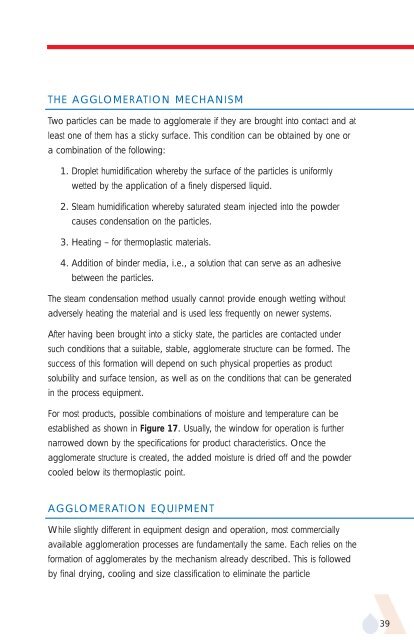APV Dryer Handbook - Umbc
APV Dryer Handbook - Umbc
APV Dryer Handbook - Umbc
You also want an ePaper? Increase the reach of your titles
YUMPU automatically turns print PDFs into web optimized ePapers that Google loves.
THE AGGLOMERATION MECHANISM<br />
Two particles can be made to agglomerate if they are brought into contact and at<br />
least one of them has a sticky surface. This condition can be obtained by one or<br />
a combination of the following:<br />
1. Droplet humidification whereby the surface of the particles is uniformly<br />
wetted by the application of a finely dispersed liquid.<br />
2. Steam humidification whereby saturated steam injected into the powder<br />
causes condensation on the particles.<br />
3. Heating – for thermoplastic materials.<br />
4. Addition of binder media, i.e., a solution that can serve as an adhesive<br />
between the particles.<br />
The steam condensation method usually cannot provide enough wetting without<br />
adversely heating the material and is used less frequently on newer systems.<br />
After having been brought into a sticky state, the particles are contacted under<br />
such conditions that a suitable, stable, agglomerate structure can be formed. The<br />
success of this formation will depend on such physical properties as product<br />
solubility and surface tension, as well as on the conditions that can be generated<br />
in the process equipment.<br />
For most products, possible combinations of moisture and temperature can be<br />
established as shown in Figure 17. Usually, the window for operation is further<br />
narrowed down by the specifications for product characteristics. Once the<br />
agglomerate structure is created, the added moisture is dried off and the powder<br />
cooled below its thermoplastic point.<br />
AGGLOMERATION EQUIPMENT<br />
While slightly different in equipment design and operation, most commercially<br />
available agglomeration processes are fundamentally the same. Each relies on the<br />
formation of agglomerates by the mechanism already described. This is followed<br />
by final drying, cooling and size classification to eliminate the particle<br />
39











